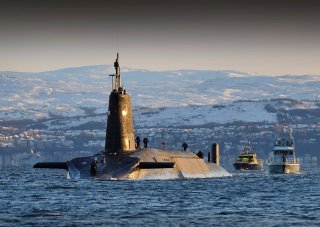Bravo Britain: Vanguard-Class Nuclear Submarines are First Class
The United Kingdom’s Vanguard-class is small in number, but large in size—and is armed with incredibly powerful Trident II missiles.
Here's What You Need to Remember: A key component of these subs' lethality are their compatibility with the Trident II missiles.
The United Kingdom’s Vanguard-class is small in number, but large in size—and is armed with incredibly powerful Trident II missiles.
Four
During the Cold War, the United Kingdom prioritized deterring the Soviet Union—a difficult challenge considering the United Kingdom’s small geographic size, and relative proximity to the USSR. While the United States has a nuclear triad of land, air, and sea-based nuclear weapons, these three options are not advantageous to the United Kingdom.
Land-based nuclear missile silos are too vulnerable to attack, and strategic nuclear bombers would require too much time to become airborne. Sea-based deterrence is the United Kingdom’s primary mode of nuclear deterrence—the Vanguard-class.
The Vanguard-class is made up of just four hulls, the Vanguard, Victorious, Vigilant, and Vengeance, all of which entered service with the United Kingdom in the 1990s. Four hulls were estimated to be the minimum number required to maintain a continuous sea-based deterrence against the Soviet Union during the Cold War.
Since the Vanguard-class uses nuclear power for propulsion, they are limited only by food and water for the crew rather than by fuel. Endurance is estimated at approximately 60 days. After the last servicing of the class’ reactor cores, they will not need any further reactor maintenance for the duration of their service lives.
The class is equipped with four 533 millimeter torpedo tubes, and is armed with the deep-diving Spearfish heavyweight torpedoes. Spearfish torpedoes are very fast and can travel at just over 90 miles per hour. Additionally, the Vanguard-class is armed with the powerful Trident II missile system.
Trident II
As I wrote previously, the backbone of the United Kingdom’s deterrence-at-sea is the Trident missile system, and is an excellent example of the so-called “Special Relationship” between the United States and the United Kingdom. Both the United States and the United Kingdom operate the Trident II system with their respective Ohio-class and Vanguard-class submarines, both of which were designed to carry the American-developed Trident II missiles.
In the early 1980s, the United Kingdom bought into the American Trident missile program. The United Kingdom’s Defense Council elaborated on the advantages to the Trident system, saying that, “as with Polaris, our operational independence can remain unimpaired, there is great financial advantage in the maximum possible commonality with the United States, especially in view of the high technology, the massive scale of their own missile procurement and our long experience of working efficiently together.”
Another key advantage was related to costs, which would be lower due to the United States footing most of the research and development bill. “In addition, adopting a United States system already developed and tested makes it easier to access likely cost than with systems that require much further work.”
Boasting a maximum range of 12,000 kilometers, or about 7,500 miles, their reach is global. Each missile can carry up to eight Multiple Independent Reentry Vehicles, and each MIRV can carry a 100 or 475 kiloton nuclear warhead. By comparison, the two nuclear weapons used by the United States against Japan during the Second World War were 15 and 20 kiloton, making the Trident II orders of magnitude more powerful.
Replacements
The Vanguard-class is due to be retired by the late 2020s or early 2030s by the newer Dreadnought-class, though the Trident missile system will be carried over to the Dreadnoughts, remaining in service till the 2060s or even later. A service life of around 70 years—not bad for a missile developed in the late 1980s.
Caleb Larson holds a Master of Public Policy degree from the Willy Brandt School of Public Policy. He lives in Berlin and writes on U.S. and Russian foreign and defense policy, German politics, and culture.
This article is being republished due to reader interest.
Image: Wikimedia

